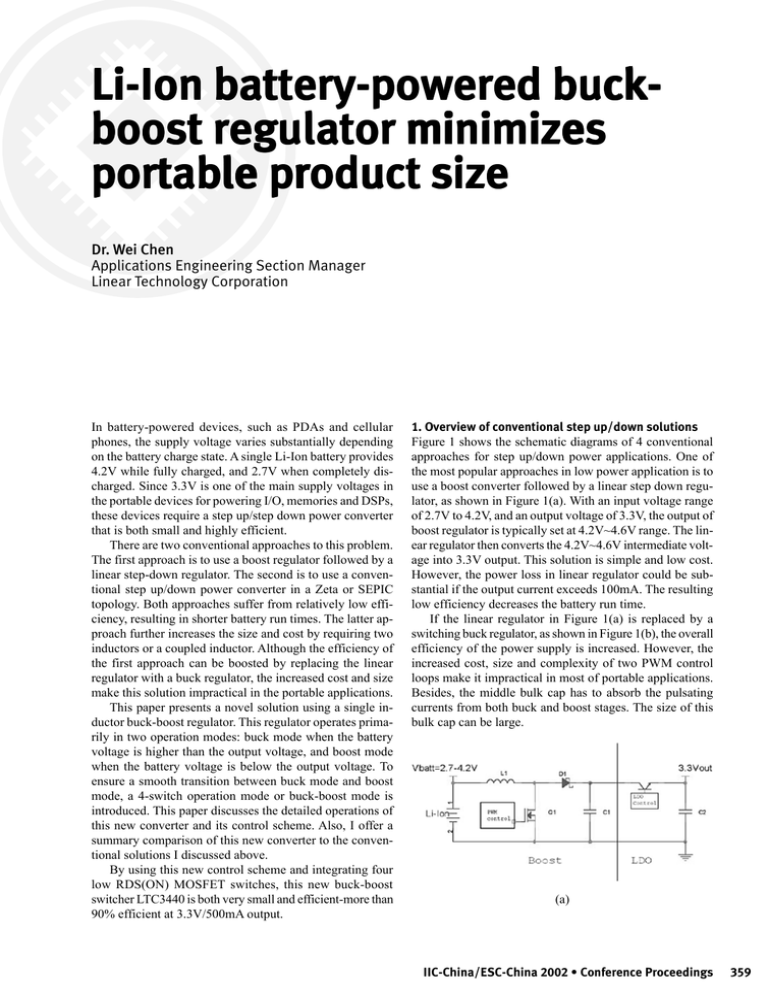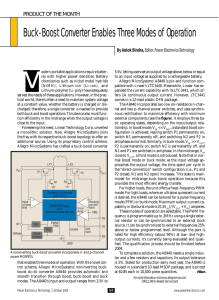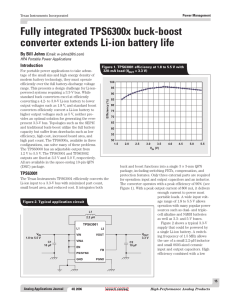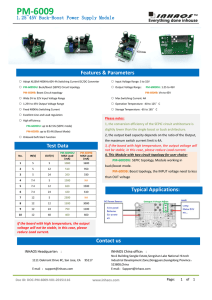Li-Ion battery-powered buck- boost regulator minimizes portable
advertisement

Li-Ion battery-powered buckboost regulator minimizes portable product size Dr. Wei Chen Applications Engineering Section Manager Linear Technology Corporation In battery-powered devices, such as PDAs and cellular phones, the supply voltage varies substantially depending on the battery charge state. A single Li-Ion battery provides 4.2V while fully charged, and 2.7V when completely discharged. Since 3.3V is one of the main supply voltages in the portable devices for powering I/O, memories and DSPs, these devices require a step up/step down power converter that is both small and highly efficient. There are two conventional approaches to this problem. The first approach is to use a boost regulator followed by a linear step-down regulator. The second is to use a conventional step up/down power converter in a Zeta or SEPIC topology. Both approaches suffer from relatively low efficiency, resulting in shorter battery run times. The latter approach further increases the size and cost by requiring two inductors or a coupled inductor. Although the efficiency of the first approach can be boosted by replacing the linear regulator with a buck regulator, the increased cost and size make this solution impractical in the portable applications. This paper presents a novel solution using a single inductor buck-boost regulator. This regulator operates primarily in two operation modes: buck mode when the battery voltage is higher than the output voltage, and boost mode when the battery voltage is below the output voltage. To ensure a smooth transition between buck mode and boost mode, a 4-switch operation mode or buck-boost mode is introduced. This paper discusses the detailed operations of this new converter and its control scheme. Also, I offer a summary comparison of this new converter to the conventional solutions I discussed above. By using this new control scheme and integrating four low RDS(ON) MOSFET switches, this new buck-boost switcher LTC3440 is both very small and efficient-more than 90% efficient at 3.3V/500mA output. 1. Overview of conventional step up/down solutions Figure 1 shows the schematic diagrams of 4 conventional approaches for step up/down power applications. One of the most popular approaches in low power application is to use a boost converter followed by a linear step down regulator, as shown in Figure 1(a). With an input voltage range of 2.7V to 4.2V, and an output voltage of 3.3V, the output of boost regulator is typically set at 4.2V~4.6V range. The linear regulator then converts the 4.2V~4.6V intermediate voltage into 3.3V output. This solution is simple and low cost. However, the power loss in linear regulator could be substantial if the output current exceeds 100mA. The resulting low efficiency decreases the battery run time. If the linear regulator in Figure 1(a) is replaced by a switching buck regulator, as shown in Figure 1(b), the overall efficiency of the power supply is increased. However, the increased cost, size and complexity of two PWM control loops make it impractical in most of portable applications. Besides, the middle bulk cap has to absorb the pulsating currents from both buck and boost stages. The size of this bulk cap can be large. (a) IIC-China/ESC-China 2002 • Conference Proceedings 359 2. Buck-boost circuit and operation principles (b) (c) Figure 2. Proposed single inductor buck-boost converter The proposed single inductor buck-boost circuit is shown in Figure 2. It does not require any middle bulk cap, resulting in a small footprint and low profile design. The maximum voltage stresses of all switching devices do not exceed VINMAX and the maximum current stress is approximately IINMAX. Therefore, low voltage low loss switching devices can be used to achieve high efficiency. There are two main operation modes: boost mode and buck mode, and one transition mode: buck-boost mode in steady state operations. 2.1 Boost Mode (VIN<VOUT) In Boost mode, Q1 is always on, turning off D1 permanently. Q2, D2, L1 and C1 form a boost converter. By regulating the duty cycle of Q2 switching, the output voltage can be regulated as: Eq. (1) (d) Figure 1. Conventional step up/down converters Another popular approach is to use a SEPIC converter, as shown in Figure 1(c). It uses only one PWM control loop and is therefore cheaper than Figure 1(b) approach. However, it requires two inductors and one extra middle cap. The voltage and current stress on the switching devices are fairly high. Both switches have to sustain a voltage stress of at least VINMAX + VOUT and the switch current must exceed IINMAX + IOUTMAX. As a result, the efficiency suffers and the cost increases. Although two inductors can be coupled onto a single core to reduce the overall footprint, the resulting two-winding coupled inductor is usually much higher in profile than the single winding inductor, and therefore not suitable for low profile applications. Another drawback of the SEPIC circuit is high output switching noise due to the pulsating output current. The other step up/down converter, Zeta shown in Figure 1(d), overcomes this drawback by producing continuous output current. Similar to SEPIC circuit, however, Zeta circuit still uses two inductors or a coupled inductor, and one middle cap. The high voltage stress and current stress in switching devices also result in a low efficiency, large size and high cost. In summary, every conventional step up/down solution has its own significant drawbacks such as low efficiency, high profile or high cost. None of them is the optimum step up/down solution for the portable devices running on a LiIon battery. where Dboost is the duty cycle of Q2 switching. The equivalent circuit is shown in Fogire 3(a) 2.2 Buck Mode (VIN<VOUT) In this mode, Q2 is always off and D2 is always on. Q1, D1, L1 and C1 implement a buck converter with Q1 as the control switch. The output voltage is estimated to be Eq. (2) where Dbuck is the duty cycle of Q1 switching. The equivalent circuit is shown in Figure 3(b) (a) boost mode (b) buck mode Figure 3. Equivalent main operation modes of Buck-boost converter 360 IIC-China/ESC-China 2002 • Conference Proceedings 2.3 Buck-Boost Mode (VIN is near VOUT) Ideally, the buck-boost converter only needs these two operating modes. In a real circuit, an accurate detection of the boundary between buck mode and boost mode is very difficult to achieve. A smooth transition between two modes is not possible. This may cause the output voltage to lose regulation during the transition. Besides, if the battery voltage fluctuates between levels of slightly above and below the output voltage for an extended period, the regulator keeps switching between two operation modes and may introduce unexpected audible noises. Therefore, a buck-boost mode is proposed to solve this transition problem. When VIN is close to VOUT, both control switches will operate actively. The buck switch Q1 has a duty cycle of Dbuck and the boost switch Q2 has a duty cycle of Dboost. The resulting output voltage is estimated to be: Eq. (3) Figure 5. (a) Block diagram of LTC3440 The transition from buck mode into this mode starts when the VIN decreases close to VOUT. Initially, only buck switch Q1 and rectifier D1 are actively switching. As the transition starts, the boost switch Q2 and rectifier D2 also start switching. The buck duty cycle Dbuck will increase as VIN decreases and the boost duty cycle Dboost will increase at the same time. At the end of transition, Dbuck becomes 100%. Eq. (3) becomes Eq. (1). The buck-boost mode ends and the boost mode starts. 3. Synchronous rectification and control schemes in LTC3440 If the rectifiers D1 and D2 in a buck-boost circuit are replaced by synchronous MOSFETs, as shown in Figure 4, the overall efficiency can be improved significantly, further extending battery run time. For a lot of Li-Ion battery powered applications, the current level is typically less than 1A. It is feasible to integrate all four FETs and the controller together into one IC. Linear Technology Corp. recently introduced LTC3440, a monolithic buck-boost regulator, suitable for single cell Li-Ion battery input. Figure 5(a) shows the block diagram of LTC3440. The power stage includes two P-FETs and two N-FETs. And the control section includes over current limit for both positive and negative current. The unique anti-ringing and anti-crossconduction techniques ensure low noise, reliable switching operation of four FETs. The selectable Burst ModeTM operation significantly reduces the power loss when the battery is in standby mode and therefore maximizes the battery run time. The control strategy of the 3 operation modes is shown in Figure 5(b). Figure 5. (b) Control Strategy of Synchronous Buck-Boost Converter In Buck mode, boost control switch C is off and synchronous switch D is always on. The buck control switch A and synchronous switch B are switching as a buck converter. In Boost mode, buck control switch A is always on and synchronous switch B is off. The boost control switch C and synchronous switch D are switching as a boost converter. In buck-boost mode, both buck and boost switches (all four switches) are switching. This control scheme allows boost mode to phase out and buck mode to phase in gradually as the input voltage decreases. The transition between step down operation and step up operation is very smooth. 4. Design examples and test results of LTC3440 circuit Figure 6 shows an all ceramic design using LTC3440 for single Li-Ion battery application. The output is 3.3V at 600mA. The operating frequency is programmed to 1MHz and soft-start is incorporated with R4 and C6. Figure 4 Buck-boost converter with synchronous rectification IIC-China/ESC-China 2002 • Conference Proceedings 361 (c) Vin=2.5V, Boost Mode, Time Scale: 0.5µs/div Figure 6. All ceramic capacitor Li-Ion to 3.3V converter at 600mA Figure 8. Switching waveforms under different operation modes (Vout=3.3V, Iout=400mA) Figure 9. Output Switching Ripple Waveform (Vin=2.5V, Vout=3.3V, Iout=400mA). Voltage Scale: 5mV/div, Tims Scale: 0.5µs/div Figure 7. Measured Efficiency vs Load Currents Figure 10. Load Transient Waveforms (Vin=3V, Vout=3.3V) Time Scale: 0.5ms/div (a) Vin=4.2V, Buck Mode, Time Scale: 0.5µs/div (b) Vin=3.5V, Buck-boost Mode, Time Scale: 0.5µs/div 362 IIC-China/ESC-China 2002 • Conference Proceedings The efficiency curves versus load currents for the LiIon battery range are shown in Figure 7. With Burst Mode Operation enabled at light loads, efficiencies of over 85% are achieved for more than 3 decades of load current. At 200µA, the efficiency remains above 70%, primarily due to the low 25µA quiescent current. If the load demand is known, the converter can be commanded to enter this power saving Burst Mode operation by driving the MODE/SYNC high. Figure 8 shows the switching waveforms for different operation modes in the LTC3440 buck-boost circuit. Only buck switches are involved in switching in buck mode and only boost switches are engaged in switching in boost mode. In buck-boost mode, all four switches are engaged in switching. Figure 9 shows the worst-case output ripple waveform. With only 22µF ceramic cap on the output, the maximum ripple voltage is less than 12mVP-P. The LTC3440 incorporates a high speed OP AMP to achieve wide bandwidth loop compensation. The load transient response, as shown in Figure 9, is very good. 5. Summary Table 1 shows a comparison between different step up/step down solutions. The proposed single inductor buck-boost converter minimizes the voltage and current stresses in all of the power devices, thus optimizing efficiency. The LTC3440-based design has a unique Burst Mode operation and low quiescent current that further extend light load efficiency and increase battery run time. Its integrated the FET switches and ability for synchronous rectifications at high switching frequency, allow solutions that use the LTC3440 to work with a few small components. As a result, the LTC3440 design provides the best ratio of performance vs. cost for Li-Ion battery powered applications. About the author Dr. Wei Chen Linear Technology Corporation 1630 McCarthy Boulevard, Milpitas, CA 95035 USA Phone: (+1-408) 954 8400 E-mail: wchen@linear.com Website: www.linear.com Dr. Wei Chen received his MS and Ph.D. degree from Virginia Polytechnic Institute and State University in USA and BS degree from Zhejiang University in China, all in electrical engineering. He has been employed at Linear Technology Corp since Nov 1998 as an Applications Engineering Section Manager. He is currently supervising the computer and communication power applications. Prior to joining Linear Technology Corporation, he has Product Development Manager at VPT, Inc. at Blacksburg, VA, USA. He was in charge of developing DC/DC power supply modules for computer and communication applications. Dr. Chen has published 9 IEEE conference and transaction papers and research reports. Currently, he holds two U.S. patents and has two more pending. Table 1. Comparison of Different Step Up/Down Converters (* Shaded area = best) IIC-China/ESC-China 2002 • Conference Proceedings 363




